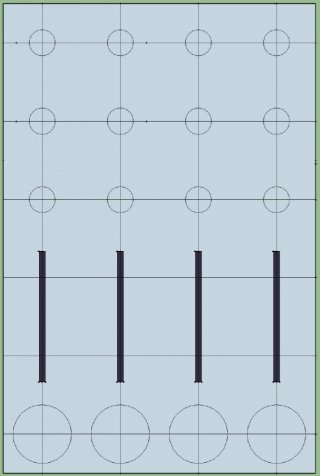Alright, so I'm just getting into the "doing things" phase of my project, and I thought now would be a good time to start a thread to make sure I'm on the right track.
I've done some research so far to at least get a baseline understanding of Teensy and the code I will be using, and have started reading a book on the topic as well.
My plan is essentially two different MIDI controllers; I will build one first, then the other. They are definitely a little ambitious, but I am up for the challenge, and if all goes well I will be well armed with knowledge and parts for future projects.
Midi controller B is my first build; 16 arcade buttons with 5v white LEDs +6 potentiometers (4 knobs, two faders), and I think I can fit 4 more buttons (regular kind,not arcade) for octave +/- and note +/-
Midi Controller A will be second build; 16 knobs (4 are sliders), 4 buttons (banks), and 4 LEDs (bank selection)
I purchased two Teensy 2.0's a little sooner than I should have, but I think they will suit my needs, so long as they can handle the number of '4051 and '595 chips I will be using.
Which is my first question: Model B is planning to have two 74HC4051s and one 74HC595 and Model A is planning to have .... four(?) 74HC4051s (I think... I haven't fully planned that one out yet) - Should I expect any latency/ghosting/general problems with this setup? It seems like the number of chips I'm adding isn't exactly uncommon, but since I am using it for music production, smoothness and accuracy are important.
Second question might be hard to explain: I intend to have the four buttons on Model A swap banks of MIDI CC. That should give me access to 16 faders (4 at a time) and 48 knobs (12 at a time).
This question might be more to do with MIDI than anything, but is there anything special I need to do to make sure when I swap banks that the MIDI mapped knobs do not all jump to the position of the physical knob.
Does that make sense? Most Digital Audio Workstations (DAW) have settings to change how knobs interact with mappings. You can often swap between "pickup" or "latch". Pickup means the value does not change until the knob passes the current value; it then "picks up" the knob at that point. Latch will jump to the knob the moment it is moved.
Let me know if I can provide you guys with anything else. I have zero code really (other than some practice stuff in a text doc).
I'll post pictures of my box blueprints. The big circles are arcade buttons, the small ones are knobs, and the black skinny rectangles are faders.
Thanks guys. Love the site, love teensys, love DIY.
I've done some research so far to at least get a baseline understanding of Teensy and the code I will be using, and have started reading a book on the topic as well.
My plan is essentially two different MIDI controllers; I will build one first, then the other. They are definitely a little ambitious, but I am up for the challenge, and if all goes well I will be well armed with knowledge and parts for future projects.
Midi controller B is my first build; 16 arcade buttons with 5v white LEDs +6 potentiometers (4 knobs, two faders), and I think I can fit 4 more buttons (regular kind,not arcade) for octave +/- and note +/-
Midi Controller A will be second build; 16 knobs (4 are sliders), 4 buttons (banks), and 4 LEDs (bank selection)
I purchased two Teensy 2.0's a little sooner than I should have, but I think they will suit my needs, so long as they can handle the number of '4051 and '595 chips I will be using.
Which is my first question: Model B is planning to have two 74HC4051s and one 74HC595 and Model A is planning to have .... four(?) 74HC4051s (I think... I haven't fully planned that one out yet) - Should I expect any latency/ghosting/general problems with this setup? It seems like the number of chips I'm adding isn't exactly uncommon, but since I am using it for music production, smoothness and accuracy are important.
Second question might be hard to explain: I intend to have the four buttons on Model A swap banks of MIDI CC. That should give me access to 16 faders (4 at a time) and 48 knobs (12 at a time).
This question might be more to do with MIDI than anything, but is there anything special I need to do to make sure when I swap banks that the MIDI mapped knobs do not all jump to the position of the physical knob.
Does that make sense? Most Digital Audio Workstations (DAW) have settings to change how knobs interact with mappings. You can often swap between "pickup" or "latch". Pickup means the value does not change until the knob passes the current value; it then "picks up" the knob at that point. Latch will jump to the knob the moment it is moved.
Let me know if I can provide you guys with anything else. I have zero code really (other than some practice stuff in a text doc).
I'll post pictures of my box blueprints. The big circles are arcade buttons, the small ones are knobs, and the black skinny rectangles are faders.
Thanks guys. Love the site, love teensys, love DIY.



